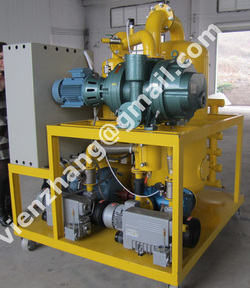 The primary function of vacuum dehydration and purification is to remove free, emulsified, and dissolved water from oil, as well as solid particulate contamination. The secondary function of the system is the extraction of air, gases, and light hydrocarbon contamination from the oil. These functions are accomplished using the principles of low temperature vacuum distillation and micronic filtration. Vacuum Dehydration - Many are aware that vacuum dehydration will remove free, emulsified and dissolved water from their lubricants. In many cases, high quality vacuum dehydration units can achieve overall water content as low as 20 parts per million. However, vacuum dehydrators also serve other functions. High quality vacuum dehydrators are equipped with high efficiency filters that can achieve particle counts as low as ISO 14/12/9. In addition, refrigerants, solvents and fuels are removed by vacuum dehydration. 1: It is for treating a range of insulating oil, including transformer oil, mutual inductor oil, change oil. 2: It is extensively applied in large scale manufacturing factory, energy station and other related industrial fields which will use transformers, specifically for more than 110 KV transformers. 3: Double point vacuum system, adopt international remarkable duplex stereo-evaparation technology and british G technology to eliminate the trace water in insulation essential oil and recover its breakdown voltage greatly. 4: Adopt Germany's 3 UG phase replay, will make the machine functioning efficaciously and safely at any situations, such as energy off, lack of phase, wrong phase position, etc. 5: Equipped with remarkable dielectric condensation devices for greatly prolong the essential oil purifier provider life. 6: A trinity of interlocked preventive unit is applied for avoid the machine becoming damanged from any incident automatically. 7: It also can be used becoming a separate vacuum method for dehydrating essential oil only, don't should operate all procedure and can save time and consumption for different ask on essential oil filtration. 8: it may purpose onsite using the transformer operating together. 9: A PLC method can be attached as per customer's requirement. 10: it may be moved easily with equipped steel wheels, it also can be created for different structure of completely enclosed type and completely enclosed trailer type to the objective of ourdoor use and indoor use. Find more oil filtration, oil purification, oil treatment, oil purifier, oil recycling
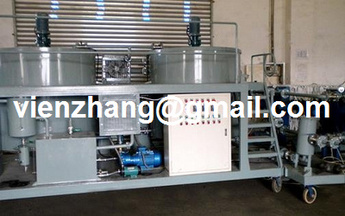 If you recycle just two gallons of used oil it can generate enough electricity to run the average household for almost 24 hours.
Cars are an indispensable fact of life for most of us. So, too, are abundant and clean supplies of drinking water. What we do with the used oil from our cars plays an important role in balancing our desire for convenient transportation with our desire for a clean and healthy environment today and for future generations.
We are all familiar with recycling newspapers, aluminum cans, glass and plastic bottles, but you may not be aware of the efforts of the petroleum industry and other groups to promote used motor oil recycling: providing convenient collection sites for the purpose of keeping used motor oil out of our waterways and ground water supplies and getting used oil into the recycling system.
Motor oil has value even after it has been drained from an engine. The oil you take to a collection center to be recycled saves energy. It can be reprocessed and used in furnaces for heat or in power plants to generate electricity for homes, schools, and businesses. It can also be sent to a refinery that specializes in processing used oil and re-refined into lubricating base oils that can be used to formulate engine oils meeting API specifications.
What can you do? If you change your own oil, be certain that you take it to a collection center for recycling. If you take your car to an automotive service outlet, you can be fairly certain that they recycle the oil that they change. But if you're not sure, ask.
Used motor oil that is collected by "do-it-yourselfers" is critical to the used oil recycling system. Next time you change your own oil, remember, you can make a difference by recycling the oil from your car, truck, motorcycle, boat, recreational vehicle or lawnmower. By dropping off your used motor oil today you help prevent pollution and conserve energy for a safer and healthier tomorrow.
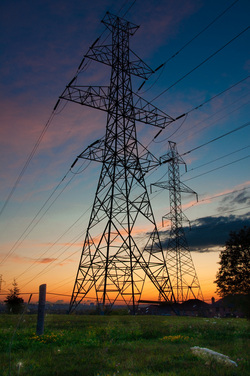 Listing requirements for less-flammable liquids
In discussing the requirements of various codes on the installation of transformers using less-flammable liquids, you'll encounter a requirement to comply with the listing of the liquid. Due to this requirement, it's important that you understand the various listing agency requirements for these units. In our discussion here, the use of the term "listing" or "listed" follows the basic definition from the National Electrical Code (NEC). This definition reads as follows:
Listed: Equipment or materials included in a list published by an organization acceptable to the authority having jurisdiction and concerned with product evaluation, that maintains periodic inspection of production of listed equipment or materials, and whose listing states either that the equipment or materials meets appropriate designated standards or has been tested and found suitable for use in a specified manner.
Less-flammable liquids are currently listed with Underwriters Laboratories (UL) and FM.
Factory Mutual. FM recommends certain practical and effective mechanical and electrical protection schemes for particular types of transformers. Fire protection is a base level of protection that FM requires for transformer installations that expose buildings or other property to potential damage. However, FM also gives consideration to omitting fire protection if the transformer installed is a less-flammable type with proper electrical and mechanical protection and if it is not installed as a network transformer.
Protection systems should be determined by an engineering study that considers the criticality of the supplied loads and the level of fire exposure that may be presented by a transformer failure. Various schemes of electrical protection can be employed from normal overcurrent protection to the inclusion of differential relays, ground relays, etc. FM's guidelines give varying degrees of overcurrent protection required based upon the transformer kVA and the supply configuration.
Per FM, all indoor transformers should be installed at least 3 ft from building walls, and containment systems should be provided for the transformer liquid in case of tank rupture. The containment area should be capable of containing the liquid from the largest transformer located within the space.
For transformers that are FM approved, the following elements are required in order to install the transformer without additional fire protection:
* Tank design strength to prevent tank rupture under low energy fault conditions;
* A pressure relief device to relieve pressure if a low current fault occurs until it can be cleared by the electrical protection;
* Electrical protection in the form of a ground fault relay, sudden pressure relay, or other device of equivalent reliability to clear sustained low current faults;
* A liquid with a firepoint greater than 300 [degrees] C; and
* Electrical protection to clear high current faults. This protection is based on the liquid volume of the transformer and is intended to electrically isolate the transformer [TABULAR DATA FOR TABLE 2 OMITTED] rapidly enough to prevent pressure increase to greater than half the tank burst pressure.
If the transformer is used on a network system, FM also requires that the transformer be installed in a room with a 3-hr construction or a room with 1-hr protection and automatic sprinkler protection.
For transformers installed outdoors, you must give some additional considerations to their location based on the insulating liquid used. In general, FM requires that they meet the above items outlined for indoor transformers and, in addition, the building should be protected by separation, fire barriers, or a water spray system.
The separation distances are shown in Table 1 (on page 80). These values show the varying degrees of separation needed between a transformer and an adjacent building. The distances increase depending on the fire hazard introduced by the volume of liquid in the transformer and the liquid type.
If the separation shown in Table 1 cannot be maintained, a fire barrier should be provided to protect the building from exposure to the fire. Fabricated barriers should be constructed of concrete block or reinforced concrete construction with a 2-hr fire rating. This barrier should extend beyond the transformer by the horizontal or vertical distances shown in Table 1.
If a building wall is used as the fire barrier, the exposed wall should be fire-resistive or noncombustible construction for transformers with less than 500-gal fluid capacity. For transformers with more than 500-gal capacity, the building wall should be of 2-hr fire resistance. In all cases, the wall should extend the horizontal and vertical distances specified in Table 1 from the transformer.
A water spray system may be provided for additional protection provided it has a discharge density of .20 gal/min over the exposed surface.
UL listing requirements
Significant revisions in the Factory Mutual Transformer Loss Prevention document in October, 1994 resulted in FM adopting a protection scheme similar to the original UL requirements. FM dropped requirements based on heat release rate and incorporated protection against tank rupture. Now, both UL and FM use mechanical and electrical protection combined with the good fire-resistance properties of less-flammable fluids to prevent transformer tank rupture, explosion, and fire. There have been no reported eventful failures involving less-flammable units with these requirements. Similar protective devices (with the addition of low current fault protection) are also used by FM for its new FMRC-Approved Transformer standard.
Presently, UL has classified only two liquids in the less-flammable category: a high molecular weight hydrocarbon (HMWH) and a silicone. Common to both classifications are the following additional use restrictions:
* They are applicable to 3-phase transformers only;
* The transformer tank must be able to withstand an internal pressure of 12 psig;
* The transformer must be equipped with a pressure relief valve with a capacity based on the transformer kVA rating;
* The transformer primary side over-current protection must be selected to meet specific energy let-through ([I.sup.2]t) specified in the use restrictions; and
In mid-1995, a revision in both UL less-flammable fluid classifications banned the use of immersed expulsion fuses that vented during operation, unless the classified fluids are tested effectively and the installation includes primarily current limiting fusing. A representative classification marking is shown in Table 2 for a specific silicone brand. In December of 1995, UL tested and reversed the internal expulsion fuse ban for an HMWH fluid classification. The resulting UL marking is shown in Table 3.
The requirement noted above takes into account the fact that many transformer designs have the primary fusing in the transformer case, under the same insulating fluid as the transformer itself. The UL-classified HMWH fluid allows the additional option of current limiting fusing (which may be used alone or in combination with under-oil expulsion fuses inside the transformer tank), or the option of external expulsion fusing without current limiting fusing, provided the let-through current/time is within the maximum allowable limit
End
(by Loyd, Richard E)
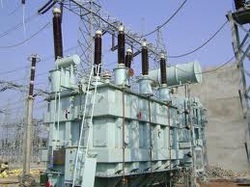 Transformer modifications
Sec. 450-28 of the NEC has some specific provisions that govern modifications to transformer installations. Although the NEC is not a retroactive document, it is specific in establishing requirements where a modification can change the entire context of a particular installation. Transformers are an excellent example of this case.
When modifications are made to a transformer that changes its type (i.e. oil-insulated to less flammable), it must comply with the appropriate requirements for the installation of the new type. The transformer must be marked to show the type of insulating liquid used in the modification. This marking is a critical element for an inspector to determine if the transformer is in compliance with its appropriate installation requirements.
This requirement for a marking and compliance with the installation requirements for the new "type" can work to a user's advantage as well. If buildings are expanded or altered such that they no longer have appropriate distance separation from, for instance, an oil-insulated transformer, then the transformer may be modified with a less-flammable liquid, and the new space separation may now be acceptable.
Transformer installation requirements in the 1996 NEC
Some changes in the requirements for the installation of less-flammable liquid-filled transformers appear in the 1996 NEC. These changes are significant enough to warrant their consideration here.
The Code-Making Panel covering transformers received proposals for Sec. 450-23 to clarify the installation requirements in both indoor and outdoor locations for less-flammable liquid-filled transformers. Per Fig. 7, you can see that one of the permitted installation methods for less-flammable liquid-filled transformers is to comply with the requirements in Sec. 450-26. These requirements are written specifically around oil-filled transformers, and the panel made it clear that the less-flammable liquids are permitted to be installed in situations identical to that for oil-filled. The basic requirement in Sec. 450-26 is to install the transformer in a vault constructed in accordance with Part C of Art. 450, unless one of the following exceptions can be met.
* If the total transformer capacity is 112 1/2 kVA or less, the vault may be constructed of 4-in. reinforced concrete.
* If the nominal voltage is 600V or less, the vault may be omitted if arrangements are made to prevent a transformer oil fire from igniting other materials, and the total transformer capacity does not exceed 10kVA in a section of a building classified as combustible or 75kVA in a section classified as fire-resistant construction.
* Electric furnace transformers can be installed without a vault where the total rating does not exceed 75kVA, and arrangements are made to prevent a transformer oil fire from igniting other materials.
* Transformers are permitted to be installed in a detached building that does not comply with the vault requirements if neither the building nor its contents present a fire hazard to any other building or property, and if the building is used only in supplying electric service, and the interior is accessible only to qualified persons.
* The vault may be omitted for transformers used in portable and mobile mining equipment with additional conditions specified.
Outdoor locations
Since less-flammable liquids are indeed less of a fire safety hazard than their mineral-oil counterparts, the 1996 NEC clarifies installation requirements for outdoor installations as well.
For installations attached to, adjacent to, or on roofs of Type I or Type II buildings, the installation shall simply comply with all of the restrictions in the listing of the liquid. A fine print note in Sec. 450-23(b)(1) notes that when the transformer is installed adjacent to combustible materials, fire escapes, or door and window openings, additional safeguards may be necessary. The safeguards noted in Sec. 450-27 may be acceptable. Note that in the 1993 NEC, this was part of the actual requirement, and the current status as FPN makes continued enforceability questionable.
For other than Type I or Type II buildings, the installation shall be installed in accordance with the same requirements as oil-filled transformers in Sec. 450-27.
NESC requirements for less-flammable liquids
The NESC is published by the Institute of Electrical and Electronics Engineers (IEEE) as ANSI/IEEE C2-1993. The document generally is used by utility companies and provides practical safeguarding of persons during the installation, operation, or maintenance of electric supply and communications lines and their associated equipment. The NESC specifically references the NEC for building utilization wiring requirements.
As the following sections will show, the NESC has very few specific requirements for transformers. This should be considered along with the fact that most utilities have their own operating and installation procedures above and beyond any code or standards requirements.
Although enforcement of the NESC is by the utility companies themselves, engineers and inspectors outside of the utility industry should be aware of NESC requirements for transformers. Since the local authority having jurisdiction is primarily [TABULAR DATA FOR TABLE 1 OMITTED] concerned with fire and personnel safety within and around public or private buildings, the location of a transformer, even one owned and maintained by the utility, can become a concern if a building or combustible materials are in close proximity.
The NESC has specific transformer requirements for installations in "electric supply stations." It defines these areas as "any building, room, or separate space within which electric supply equipment is located and the interior of which is accessible, as a rule, only to qualified persons. This includes generating stations and substations, including their associated generator, storage battery, transformer, and switchgear rooms or enclosures, but does not include facilities such as pad-mounted equipment and installations in manholes and vaults."
Outdoor installations. The NESC has language that is much less specific than that provided in the NEC. Sec. 152(A) simply requires that specified methods be used to minimize fire hazards associated with liquid-filled transformers. These specified methods include the following:
* Use of less-flammable liquids;
* Space separation;
* Fire-resistant barriers;
* Automatic extinguishing systems;
* Absorption beds; or
* Enclosures
Although the specific requirements to apply these methods are not provided in the NESC, you should consider using some of the methods described in this document, particularly if the transformer is located close to a nonutility building.
Indoor installations. The NESC categorizes transformers located indoors as liquids of flammable, nonflammable, and less-flammable types. Transformers containing flammable liquids (such as mineral oil) and rated above 75kVA must be installed in ventilated rooms or vaults separated from the rest of the building by fire walls. The specific rating of the fire walls are not given in the NESC. As such, you should consider the degree of the fire hazard when determining the rating of these walls. Doorways leading to the room or vault should be constructed with a fire-resistant rating as well. It's also required that the room or vault have a means to contain the liquid of the transformer(s), should a rupture occur.
The NESC specifies that a pressure relief vent of a transformer with a nonbio-degradable liquid, when installed, be provided with a means for absorbing toxic gases. This requirement relates to that discussed in NEC Sec. 450-24 for these transformers.
Less-flammable liquid. NESC requires that less-flammable liquid-filled transformers be installed in a way to minimize fire hazards. You must consider the type of electrical protection, amount of liquid contained, and tank venting when selecting a location for the transformer.
(by Loyd, Richard E)
to be continue...
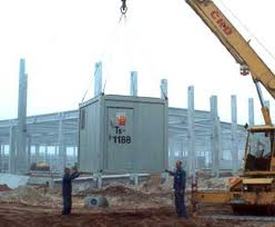 Outdoor transformer installations
The concern for fire hazards here is reduced because of the outdoor location; however, the hazard is not eliminated, and you must take the following precautions.
Less-flammable liquid-insulated transformers. The requirements for these installations can be found in Sec. 450-23. Transformers meeting the less-flammable class requirements can be installed outdoors attached to, adjacent to, or on the roof of Type I and Type II buildings, as shown in Fig. 3. (Type I and II building constructions are classified as noncombustible construction and can be further investigated in NFPA/ANS1220-1995, Types of Building Construction. Local building codes such as BOCA, ICBO, SBCCI, etc. also may influence the determination of building construction type.)
Less-flammable liquid-insulated transformers have requirements for additional safeguards if they are installed outdoors on, attached, or adjacent to buildings not meeting Type I or Type II constructions, or if they are adjacent to combustible materials. These additional safeguards are not clearly spelled out in the NEC, but some guidance is given. You should discuss this with the local authority having jurisdiction. Fire barriers, space separation, and compliance with the liquid listing requirements are all recognized safeguards in the NEC.
Fire barriers generally consist of 1-hr fire-rated materials and may be one-, two-, three-, or four-sided, depending upon the arrangements of the transformer to the occupancy. [ILLUSTRATION FOR FIGURE 4 OMITTED].
Space separation, as shown in Fig. 5, is a requirement based on the relative separation of the transformer from the building or combustible materials. To determine the proper space separation, you have to evaluate the amount of liquid and its particular heat-producing characteristics. Factor Mutual (FM) has performed such evaluations and provides recommended clearances for the various types of transformers.
Compliance with the liquid listing requirements: Basic details regarding the listing agency requirements are discussed later.
The NEC also requires that similar safeguards to the ones discussed above be taken if the transformer is located adjacent to fire escapes or door/window openings. The intent with this precaution is to ensure that adequate means of egress from the building is provided if the transformer is in a failure mode.
Sec. 450-24 covers this class of transformer for outdoors installations as well. No special requirements exist for these transformers installed outdoors. They must be designed and constructed to absorb any gases generated by arcing inside the tank, or the pressure relief vent must be vented to an environmentally safe area.
Oil-insulated transformers. Sec. 450-27 of the NEC is specifically dedicated to these transformers installed outdoors. The NEC does not provide any special requirements for these transformers if they are installed adjacent to, attached to, or on the roof of a building of noncombustible construction (except when installed close to doors, windows, or means of egress). However, good engineering judgment should be used when installing in these locations.
Oil-filled transformers can have failures resulting in a transformer fire, and the potential impact of that fire on the building should be evaluated. The heat convection and radiation rates of the oil should be reviewed and compared with the ability of the building construction to handle the heat released during a fire. Some guidance to this type of evaluation is provided in the "Listing Requirements" section of this article, on page 80. Also, you should reference IEEE 979-1992, Guide For Substation Fire Protection.
Additional information can be obtained from insurers for guidance. FM, for instance, gives a number of reasonable guidelines for these transformers where they are installed adjacent to a building.
For other situations, the NEC requires that "combustible materials, combustible buildings, parts of buildings, fire escapes, and door and window openings shall be safeguarded from fires originating in oil-insulated transformers installed on roofs, attached to, or adjacent to a building or combustible material."
The recognized safeguards, as shown in Fig. 6 (on page 79), are space separations, fire-resistant barriers, automatic water spray systems, and enclosures that confine the oil of a ruptured tank.
(by Loyd, Richard E)
to be continue...
|






 RSS Feed
RSS Feed


